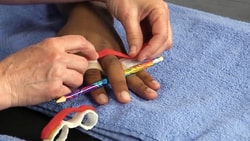Unbuttoning the Complex Chronic Boutonniere Deformity
Managing a chronic Boutonnière deformity can be complex—but the right conservative treatment makes a difference. Learn key techniques like serial casting and relative motion orthoses to improve outcomes and restore function.
December 22, 2022
2 min. read

What Is a Boutonnire Deformity?
A boutonniere or buttonhole deformity involves a proximal interphalangeal (PIP) joint flexion contracture with distal interphalangeal (DIP) joint hyperextension.
This occurs due to disruption within the extensor system, specifically:
The central slip loses the ability to extend the PIP.
Lateral bands slide volar and become PIP flexors.
Rheumatoid arthritis can also lead to Boutonnire deformities.3
How are Boutonniere Deformities Classified for Treatment?
Boutonniere deformities can be classed as:
Acute non-surgical
Open acute post-surgical
Chronic non-surgical
Chronic post-surgical
What Is the Best Non-Surgical Way to Conservatively Treat a Chronic Boutonniere Deformity?
The boutonniere deformity can be challenging to treat conservatively, but the best ways are:
Serial casting: Utilized in an attempt to obtain full PIP extension. During casting and over the six to eight weeks of the orthosis-weaning process, it is important for the patient to complete distal interphalangeal joint flexion exercises to promote dorsal migration of the lateral bands, delaying full motion until full active PIP extension is achieved.
DIP joint motion: Helps to draw the lateral bands dorsal to the PIP joint axis of rotation.5
A relative motion orthosis can also be used for patients with full PIP extension with the pencil test. This orthosis places the metacarpal phalangeal joint in 20 more degrees of flexion than the lateral digits.4,8
[gallery size="full" columns="2" link="none" ids="12863,12864"]
Serial casting can be very effective in increasing PIP joint extension in chronic cases, but DIP joint active flexion must be encouraged to promote the dorsal migration of the lateral bands. A relative motion orthosis is a good option for those with full PIP extension with the pencil test. While treating chronic boutonniere deformity can be a long process, with both the therapist and the patient, good outcomes are possible.
Below, watch Jeanine Beasley discuss Boutonnière deformity treatment in this brief clip from her Medbridge course “Extensor Tendon Rehabilitation Update: Zones III - IV."






